JonBenét Patricia Ramsey was a six-year-old beauty pageant contestant who was brutally murdered (and possibly raped) in her home, on the night of 25 to 26 December 1996. The case is officially unsolved, and has become one of the most mysterious and controversial in America's history.
Background[]
JonBenét was born on August 6, 1990, in Atlanta, Georgia. She was named after her parents, John Bennett Ramsey, a businessman, and Patricia "Patsy" Ramsey, a socialite and the Miss West Virginia of 1977. She had an older brother, Burke Ramsey, and two half-sisters from her father's first marriage: Melinda and Elizabeth Ramsey, the latter of whom died in an automobile accident when JonBenét was two years old. In 1991, the family moved to Boulder, Colorado, where Mr. Ramsey took on as the chief executive of a computer company who recently merged with his own. JonBenét attended High Peaks Elementary School and was a member of St. John's Episcopal Church of Boulder. She was also a frequent competitor in children's beauty pageants (it was later argued that this was one of the main reasons why the case became so famous), winning her first one, the Colorado State All-Star pageant of 1994, at the age of four.
Case History[]
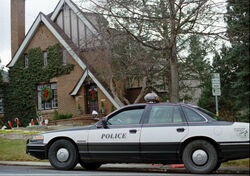
The Ramsey house.
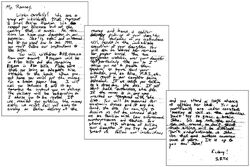
The ransom note.
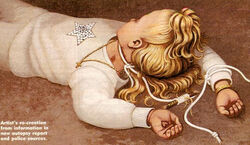
Artist's recreation of the state of the body when it was found.
Early in the morning of December 26, 1996, around 5:45 a.m., Patricia Ramsey woke up, discovered that JonBenét was missing, and found a two-and-a-half-page-long hand-written ransom note addressed to Mr. Ramsey, claiming that their daughter had been kidnapped by "a group of individuals representing a small foreign faction". It demanded a ransom of $118.000 (almost exactly the very same amount Mr. Ramsey received as a Christmas bonus from his company), with very specific instructions about the bills' denomination and how they were to be delivered. It ended with the word "Victory!", and was signed "S.B.T.C.". Mrs. Ramsey called the police, who came and searched the house finding no obvious signs of forced entry, with the exception of a broken window in the basement, which was said by John Ramsey to have been broken by him months earlier, when he got locked out without his keys. In the meantime, some family friends and a local minister arrived, and the Ramseys made preparations to pay the ransom. In the afternoon of the same day, the body of JonBenét was found in the house's wine cellar by Mr. Ramsey and one of the family friends, Fleet White, who were searching the house for clues on the advice of one of the detectives: Linda Arndt. The little girl's white blanket was wrapped around her torso; her right hand was bound with a piece of rope, which also made up a handcrafted garrote surrounding her neck; and her mouth was taped over with black duct tape. Mr. Ramsey quickly picked her up, loosened her bonds and carried her into the living room, but she was already long since dead. The postmortem examination and autopsy of the body revealed that Ramsey had been strangled twice with a nylon cord, which had been tied to a piece of a paintbrush from the basement, presumably for leverage, in the guise of a rudimentary garrote. There were also clear signs of blunt force trauma to the head, signs of possible sexual assault, and (according to a theory developed by detective Lou Smit) electrical burns on the cheek, suggesting that she may also have been tasered. The official cause of death was ruled as asphyxia by strangulation associated with craniocerebral trauma.
The murder of JonBenét Ramsey quickly became a media sensation and several theories began to circulate. One was that Mr. Ramsey had molested his daughter and killed her to cover it up. Another was that Mrs. Ramsey had killed her in a fit of rage after finding that she had wet her bed (she was a frequent bedwetter and even had to wear diapers, in spite of her age) and covered it up as a home invasion. The police made it clear early that they were focusing on the parents rather than "some mad kidnapper". One story that was aired was that there were no footprints in the snow near the open basement window, though an investigator rebutted it by remarking that there were other entrances (including the broken window in the basement) where there was no snow that could have been used to enter without leaving footprints. When videos of JonBenét taking part in pageants were shown in the news on television, they sparked an outrage from people, who found them inappropriate for children that young. The Ramsey's asserted that competing in pageants was JonBenét's own choice and that it wasn't very different from other types of child performances. On New Year's Day of 1997, the day after JonBenét's burial in Georgia, Mr. and Mrs. Ramsey made a personal appearance on CNN. Though they defended themselves, they were painted out as the guilty ones. The story kept running in the media while the investigation continued and led nowhere. The police were later criticized for the way they handled the investigation, such as neglecting to seal off the crime scene from civilians.
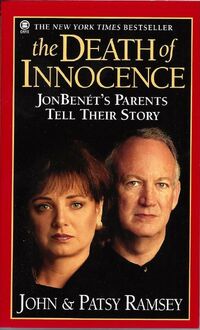
The Death of Innocence.
The case eventually went cold. The Ramsey's spent the following years defending themselves, filing lawsuits against newspapers for the way they were portrayed by them and also writing a book about their daughter's murder and their life after it: The Death of Innocence. In December of 2003, investigators found a mixed blood sample on JonBenét's underwear large enough to establish a DNA profile, belonging to an unknown male (the evidence was deemed irrelevant by some, who went as far as to sustain that it could well have been left on the underwear during manufacturing). The Ramsey family was investigated again and was cleared by the new evidence. A number of local sex offenders were also investigated but were also cleared. In June of 2006, Patricia Ramsey passed away from ovarian cancer. Later that same year, a former school teacher named John Mark Karr was arrested for JonBenét's murder after confessing to it, claiming it to have been an accident. His confession had several contradictions to the evidence: he claimed to have abducted her while she was on her way to school (even though school was not in session at the time, and JonBenét was last seen sleeping in her bed before her murder), and to have drugged her even though the autopsy showed no traces of drugs in JonBenét's system. He was eventually cleared by the DNA evidence and the charges against him were dropped. In 2008, the Ramsey family was completely cleared by new "touch DNA" technology.
In October of 2010, the case was reopened, and new interviews were conducted following an inquiry by a committee that included both state and federal investigators. The police were expected to use the latest DNA technology in the investigation. On January 27, 2013, it was announced that a grand jury had found sufficient evidence to indict JonBenét's parents in 1999 on charges of child abuse resulting in death, but the District Attorney had refused to sign the indictment, leaving off the impression that the investigation conducted by the grand jury was judged as inconclusive. In September of the same year, Daily Camera reporter Charlie Brennan and the Reporters Committee for Freedom of the Press filed a lawsuit in order to pressure DA Stan Garnett to release the indictment. During October, the judge ruled that Garnett must show why the indictment should remain sealed. The Denver Post, which is a sister paper of the Daily Camera, published an editorial that again called for the indictment to be unsealed. On October 25, court documents that were sealed in 1999 were released; they revealed that a 1999 grand jury had indicted the Ramsey parents for child abuse resulting in death and being an accessory to a crime, including murder. The papers also alleged that both parents intended to prevent or delay the arrest of the alleged killer. However, the indictments released did not specify who killed JonBenét. This release of new information thrust the case back into nationwide media coverage. To date (May, 2020), the case is ongoing.
Suspects[]
Family Members[]

John and Patsy Ramsey.
- John Bennett Ramsey:
- Businessman
- Victim's father
- Speculated by some to have abused and murdered his daughter
- Controversially cleared in 2003 and 2008 by DNA evidence
- Patricia "Patsy" Ramsey:
- Former beauty queen of West Virginia
- Victim's mother
- Speculated by some to have murdered her daughter in a fit of rage, which was prompted either by JonBenét bedwetting or by her intention to leave pageants (although she reportedly loved them)
- Believed by some to have written the ransom note, but later cleared by a federal court which cited six certified handwriting experts
- Died of ovarian cancer in 2006
- Controversially cleared in 2003 and 2008 by DNA evidence

Burke Ramsey in 2016.
- Burke Ramsey:
- Victim's brother
- Nine-year-old at the time
- Speculated by some to have accidentally murdered his younger sister, with his parents protecting him
- Was never officially considered as a suspect by the authorities
- Controversially cleared in 2003 and 2008 by DNA evidence
Others[]
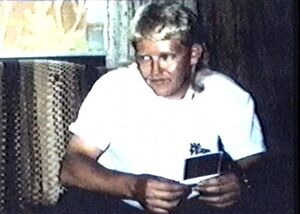
Michael Helgoth.
- Michael Helgoth:
- 26-year-old at the time
- Served thirteen months in the Army
- Electrician and scrap dealer
- Collected military paraphernalia
- Turned in in 1997 by colleague John Kenady, a convicted child molester and repeat offender who claimed Helgoth expressed to him his desire to "crash a human skull", and even admitted to the murder on a recording (never to be found) which, he further claimed, was in the possession of an accomplice of Helgoth
- Kenady claimed Helgoth revealed to him he and a partner were going to make a great deal and they each will bring in around $50,000 or $60,000 (which, multiplied by two, approaches $118.000)
- Considered as a suspect by one of the Ramseys' private investigators, Ollie Gray, who defined him a "hellraiser". He was also deemed as a likely suspect by private investigators who worked for the Boulder District Attorney's office. Boulder police, however, held a different view and determined Helgoth could not be linked to the crime by any means
- Approximately matched John Douglas' profile
- Was allegedly briefly involved in a property dispute with the Ramseys, although no evidence was ever found of this
- Possessed a pair of boots identical to the ones which left a footprint in the Ramseys' basement. However, the print was confronted with Helgoth's boots by Boulder police and they apparently didn't match
- According to CNN, a baseball cap with the acronym "S-B-T-C" was found in his possession
- Possessed a stun gun
- Had two wolfdogs which some speculated were the source of animal fibers found on JonBenét
- Was depressed and high on drugs towards the end of his life. He eventually committed suicide on February 14, 1997, soon after Boulder District Attorney Alex Hunter announced on TV that the investigation was zeroing in on a suspect (although the statement was meant for Patsy Ramsey)
- Some speculated his suicide was staged by the real killer of JonBenét Ramsey, with whom Helgoth had purportedly participated in the murder. Some even accused Kenady, who was stated to suffer from mental-health issues
- Controversially cleared by DNA evidence
- Chris Wolf:
- Local reporter
- Turned in by Jacqueline Dilson, his live-in lover
- According to Dilson, Wolf was out all night on December 25. When he finally came back, his clothes were dirty, he had a shower, and later went to sleep
- According to Dilson, Wolf became agitated when he saw news reports about the murder, and lashed out against John Ramsey, accusing him of being the murderer
- According to Dilson, Wolf hated big companies and was fascinated by political disputes and political violence
- Again according to Dilson, Wolf possessed a sweatshirt with the acronym "S-B-T-C" (which stood for Santa Barbara Tennis Club) on it
- Busted for a suspended license, he reportedly made remarks that Boulder police would have made better use of their time by chasing the killer of JonBenét Ramsey
- Interrogated, he refused to provide a handwriting sample and was eventually released
- Dilson claimed Wolf's handwriting was similar to the one in the ransom note. Handwriting expert Lloyd Cunningham could not eliminate him as a possible author
- According to Wolf himself, detectives working on the JonBenét case (John Eller and Steve Thomas) expressed they were not interested in him
- Sued the Ramseys for libel because they had included in their book his name as a possible suspect

Gary Oliva.
- Gary Oliva:
- Known sex offender
- Was in Boulder at the time of the murder
- When arrested on drug charges in 2000, he was found with a JonBenét cutout and a stun gun in his possession
- Considered as a potential suspect by Ollie Gray
- Michael Vail, a high-school friend of Oliva, claimed he phoned him not long after the murder and stated he had "hurt a little girl". Vail also claimed the knots used to bound JonBenét were similar to those used by Oliva in an incident where the latter attempted to strangle his own mother with telephone cord
- Controversially cleared by DNA evidence
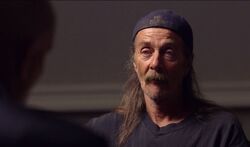
Todd Fuss.
- Todd Fuss:
- Turned in by his imprisoned wife, Bernice Johnson
- Their child was possibly part of the same pageants JonBenét attended
- Was claimed by Johnson to have peeped young girls getting dressed
- Controversially cleared by DNA evidence
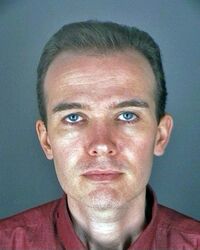
John Mark Karr.
- John Mark Karr:
- Former substitute teacher
- Arrested for possession of child pornography in California in 2001. The charges were dropped when the computer on which it was allegedly stored was lost.
- Confessed to killing Ramsey, but the confession was flawed and inconsistent with the evidence
- Controversially cleared by DNA evidence in 2006
- Arrested again for domestic violence in 2007
- Has undergone hormone replacement treatment and briefly lived as a woman named "Alexis Reich"
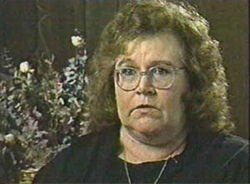
Linda Hoffman-Pugh.
- Linda Hoffman-Pugh:
- Ramseys' housekeeper
- Had the Ramseys' house keys
- Asked Patsy Ramsey for a loan to pay her rent
- Once asked JonBenét's grandmother if the family ever had any fears about the girl being kidnapped
- Voiced suspicions that Patsy Ramsey killed JonBenét
- Was never officially considered as a suspect by the authorities

Bill McReynolds.
- Bill McReynolds:
- Santa Claus impersonator who entertained JonBenét and other kids around Christmas time
- Kept a vial of glitter given to him by JonBenét during his heart surgery, and later asked his wife to mix the glitter to his ashes after his death
- On December 26, 1974, the McReynolds' 9-year-old daughter had been kidnapped along with her friend and she witnessed the sexual abuse of her friend during the trauma. The perpetrator was never caught
- His wife wrote a play about the case of Sylvia Likens, a 16-year-old girl who was tortured and killed in a basement
- Deemed very unlikely by most to be related to the crime in any way
Profile[]
Retired FBI profiler John Douglas was heavily criticized by both detectives who took part in the investigation and his former colleagues (including Robert Ressler, whom referred to Douglas as a "Hollywood kind of guy"), for his involvement with the Ramseys (who paid him for his consultation) and his theory that the killer was actually an intruder and not a family member. Profilers who believed the killer to be someone from inside the house include: James R. Fitzgerald, Jim Clemente, Gregg McCrary, and Ressler himself. Candice DeLong, on her part, sustained the intruder theory. Douglas eventually defended himself claiming that he wasn't in any way biased by his relationship with the Ramsey's and would never have excluded them had he not been absolutely convinced in the first place.
In the book he wrote in cooperation with Mark Olshaker, The Cases That Haunt Us, Douglas proposed two theories as to what likely happened that night:
- The first one involved a white male, relatively young, who held a personal grudge against John Ramsey and intended to carry it out by abducting and molesting his daughter, the most valuable thing in the world to him. Armed with a flashlight, Air Taser stun gun, rope, and a roll of duct tape, he entered the house in some way (either through the broken window or with a key), and wrote the ransom note (or rewrote one he had already sketched on Patsy's pad) after seeing John's pay stubs, getting out more of his anger and resentment while he waited for the Ramsey's to arrive. After the family fell asleep, the intruder likely stole to JonBenét's room, incapacitated her with the stun gun, taped her mouth, and brought her down in the basement. There, he bound her hands and employed a broken paintbrush handle to form the garrote which accidentally killed her (or nearly did so). When he realized what he had done, he panicked, finished off the job with a blow to her head, and fled.
- The second one involved an intended kidnapping by one or more teens or young adults who had been inside the house and had seen John's pay stubs. Maybe they were friends of one of JonBenét's baby-sitters, workmen, or friends of friends. To a teen, $118,000 would be a lot of money. He would also be unsophisticated as to have no idea how difficult it is to pull off a kidnapping, even that of a six-year-old girl. He would be bold and foolhardy enough to enter the house and wait there, writing the ransom note that he forgot to bring with him initially. In this case, both the stun gun and the garrote would have been instruments of control rather than torture. The digital penetration of the vagina would have represented the young man's casual sexual experimentation while he had the opportunity. Again, when he realized he had killed his victim, he panicked and fled. Since a teen or group of teens will usually fold when confronted by investigators, it is likely that he slid under the radar.
Douglas added that the ransom note appeared to have been written by a film buff, possibly a young man, because of the repeated usage of phrases that seemed to have been inspired by films with extortionists in their plots (e.g. Dirty Harry, Speed ("Don't try to grow a brain, John"), Ransom). The word "beheaded", on the other hand, seemed to draw from the fantasy/medieval imagery.
On Criminal Minds[]
- Season Three
- "Children of the Dark" - The JonBenét Ramsey case was mentioned when the BAU investigated a series of fatal home invasions in Denver, Colorado. During the briefing, Hotch says that it was hard for the investigators to ask the FBI for assistance since a couple of agents publicly criticized the local police, which "took on a life of its own" when the piece was published statewide.
- Season Four
- "A Shade of Gray" - While the case was not directly mentioned or referenced in this episode, it appears to have been an inspiration for Danny Murphy - Both cases involved a younger sibling killed by their older brother (possibly in JonBenét's case) in a fit of rage, and both murders (possibly in JonBenét's case) involving toy sets of large vehicles (trains in JonBenét's case, planes in Murphy's). However, it should be noted that while Burke Ramsey testified before a grand jury, he was never considered or treated as a suspect in his sister's murder.
Notes[]
- In one of his online rants, future Columbine killer Eric Harris talked about her. He said her murder was bound to happen due to putting a four-year-old in beauty pageants, called her a slut, and speculated that her father was the murderer.
- A man named James Selby claimed responsibility for JonBenét's murder and additionally to the murder of Danielle van Dam (whom David Westerfield was convicted and sentenced to death for). Selby was a registered sex offender active in five different states. He committed suicide by hanging himself on November 22, 2004 while awaiting sentencing.
Sources[]
- Wikipedia's article on the case
- TruTV Crime Library articles about the Ramsey case
- Biography.com about Ramsey
- The Cases That Haunt Us (2000)
- 101 Crimes of the Century (2008)
- JonBenet-Ramsey.com
- wc.arizona's article on Selby
- Who Killed Jonbenet Ramsey? 8 Possible Suspects - Rolling Stone
- JonBenet Ramsey Case Encyclopedia / Acquaintance Sexual Predators
- JonBenet Ramsey's REAL murderer is 26-year-old son of a junkyard owner who killed himself after her death claims investigator hired by the child beauty queen's parents
- Who killed 6-year-old pageant star JonBenet Ramsey? Here are 8 possible suspects
- JonBenet Ramsey Case Encyclopedia / Foreign Political Faction
- Article from BoulderNews Ramsey Archive
